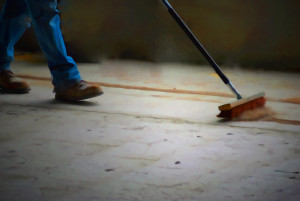 “What’s so bad about having a little bit of dust around? It’s not like it’s really hurting anything, is it?”
“What’s so bad about having a little bit of dust around? It’s not like it’s really hurting anything, is it?”
Most manufacturing plants produce some sort of dust during the manufacturing process, and with proper cleaning it doesn’t cause an issue. The problems come when employees begin to think like the above, and don’t make it a habit to clean the dust or understand the risks that dust accumulations can create.
Here are Five reasons that you SHOULD get rid of dust:
1. Can clog HVAC system
Typically, the dust you can actually see with the naked eye only accounts for ten percent of the total amount of dust in the air. These smaller particles can stay suspended in the air for days at a time, where they can work their way into the HVAC system. Over time, this dust can clog the ventilation system, causing it to work harder and less efficiently, as well as recycling dirty air back into the building.
2. Quality Control Issues
Dust on the floor is a sign that there is dust elsewhere in the building, including high up and out-of-sight areas. When the dust on these rafters and pipes is disturbed it can fall down onto machinery and production equipment, causing quality control problems and even damaging the machinery.
3. Health Risks and Accidents
Dust particles 2.5 microns or smaller are able to get into the lower sections of people’s lungs, where they can’t be brought up or dissolved in the bloodstream. These particles can cause health issues such as allergies, respiratory problems, lung disease, and in some cases even cancer. Even bigger pieces of dust can cause allergies and illness in workers.
Dust can also be a slipping hazard when it collects on walking surfaces; the small particles reduce the traction that people are used to when walking in a building. Slips are one of the main causes of workplace injury, and within those injuries dust is one of the main causes of those slips.
4. OSHA Fines
OSHA has been paying attention to the dangers that dust in the workplace can create and has been cracking down on companies that aren’t following housekeeping rules. The Combustible Dust National Emphasis Program was created by OSHA to deal with this issue, and has already cited almost five thousand businesses for dust accumulations, with fines ranging from thousands of dollars to hundreds of thousands.
5. Risk of Combustible Dust Explosion
Many types of dust become explosive under the right conditions, and there have been numerous cases of uncleaned dust coming into contact with an ignition source and exploding. The dust explosion pentagon has been created to explain how these explosions form and how to prevent them, and OSHA and the NFPA have been developing new codes to help combat this issue.
Want to remove dust from your facility to prevent explosions and keep employees healthy? Contact us now to find out how we can help.
888-845-3952 or Contact Us
Hughes Environmental technicians are expertly trained in the best methods for cleaning combustible dust hazards and use equipment specifically designed for combustible dust cleaning.
Hughes Environmental is a National Air Duct Cleaner’s Association (NADCA) certified company who has earned their prestigious “Outstanding Safety Award” every year that we’ve been in business.
Our technicians are trained on the most up-to-date industry standards for cleaning commercial HVAC systems, and are equipped to clean from the point the air enters the system all the way to where it exits.

